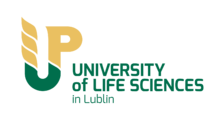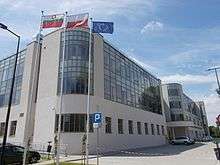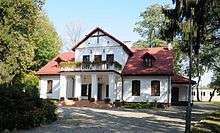University of Life Sciences in Lublin
| Uniwersytet Przyrodniczy w Lublinie | |
 | |
| Type | public |
|---|---|
| Established | 1955 |
| Rector | prof. dr hab. Marian Wesołowski |
| Address | Akademicka 13, 20-950 Lublin, Poland, Lublin, Poland |
| Website | http://www.up.lublin.pl/english/ |


The University of Life Sciences in Lublin (Polish: Uniwersytet Przyrodniczy w Lublinie) is a multi-profile higher education institution, which integrates a wide range of agricultural, biological, veterinary, technical and socioeconomic sciences[1] in Poland. Although the university was established in 1955, its history stems back to 1944 with the creation of the Agrarian and Veterinary Faculties within the new Maria Curie-Skłodowska University (UMCS). In 1955, these two faculties, together with the Faculty of Zootechnics (est. 1953), were spun off to create a new institution, originally called the Lublin Higher School of Agriculture. It was called the Lublin Agricultural Academy from 1972, and took its present name in 2008.[2]
History
The University traditions date back to 1944, when the first four Faculties were created at the recently established Maria Curie-Skłodowska University in Lublin: Medical, Life Sciences, Agricultural and Veterinary. Among the sequentially-formed faculties, in 1953 the Department of Animal Husbandry began its operations.
In 1955, during a surge of new universities, Professor Bohdan Dobrzański, the Rector of Maria Curie-Skłodowska University at the time, was appointed to create an independent scientific – didactic and research unit from the Faculties of Agriculture, Veterinary and Zootechnics. With the Resolution No. 503 of the Council of Ministers from 6 August 1955, The Higher School of Agriculture was established in Lublin. Professor Bohdan Dobrzański became its first Rector.
The dynamic development of the University and the expansion of its activities led to the establishment of two more Departments in 1970 - Horticulture (renamed Horticulture and Landscape Architecture in 2010) and Agricultural Engineering (renamed Production Engineering in 2003). In accordance with the Council of Ministers Resolution of 23 September 1972, the University was given a new name – since then, for over 35 years, it was known as the Agricultural University in Lublin.
In 1960 the Agrarian Faculty was renamed the Agricultural Faculty and in 2007 its name was changed once again to the Agrobioengineering Faculty. Similarly, in 1995 the Veterinary Faculty was renamed the Faculty of Veterinary Medicine and in 1998, the Animal Husbandry Faculty was transformed into the Faculty of Biology and Animal Breeding. In May 2005, the Senate established the sixth faculty – the Faculty of Food Science and Biotechnology and in 2006, it established the seventh one - the Faculty of Agricultural Sciences in Zamość (former Institute of Agricultural Sciences), which operated until its closure in 2015.
On 6 March 2008, the Polish government passed a law which changed the names of some agricultural colleges.[3] After the bill was approved by the Senate and validated by the President of Poland it was published in the Official Gazette and became effective as of 11 April 2008. During the solemn ceremony held on 17 April 2008, the name of the University was changed to the University of Life Sciences in Lublin.
Over the past few years, the University has expanded its research infrastructure. In 2012 the Main Library – the Regional Centre for Agricultural Scientific Information was opened, a year later: the Centre for Investment and Implementation of New Technologies in Agricultural Engineering, and in 2015 – the Innovative Centre for Animal Pathology and Therapy.
Faculties
1. Agrobioengineering

Directions of research:
- optimization of production properties of soils
- reclamation, restoration and management of degraded and devastated areas; use of the waste materials in the environment shaping
- circulation elements in natural and anthropogenic ecosystems in the chain: soil – fertilizer – plant – animal
- the use of microorganisms in agriculture and environmental protection
- socio-economic determinants of enterprise development and competitiveness in agribusiness
- conditions and prospects of development of tourism in rural areas
- modern technologies in cultivation
- biological progress in agriculture
- genetic testing – breeding and technological testing of plants
- sustainability of grasslands, their utility, significance for landscape and nature
- quality assessment of raw materials, medicinal, special and energy crops
- food assessment with regard to technological and environmental conditions.
2. Veterinary Medicine

Directions of research:
- anatomical and histological structure and functioning of tissues and organs
- sub cellular regulatory mechanisms of biochemical and neuroendocrinic character
- immunological status of animals in physiological and pathological conditions
- diagnosis and treatment of the most frequent diseases in livestock and companion animals, also animals used for food production
- quality characteristics, hygiene and technology of animal food products
- influence of the environment on disease occurrence and health in animals
- preclinical and clinical evaluation of new medicines and biomaterials
- pathogenic conditioning in system disorders of neoplasmic, metabolic, neuroendocrinic, and toxic character
3. Biology, Animal Sciences and Bioeconomy
Directions of research:
- Research in the field of breeding and animal use is directed to social needs, par-ticularly in terms of food quality, healthcare, environmental protection, welfare, and genetic resources protection of livestock and wild animals. The leading objec-tive is the improvement of nutritional value of raw materials and animal products (including organic ones) with increased content of biologically active substances. They also relate to genome and proteome analysis of different animal species, ge-netic structure evaluation of a particular population and nutrigenomics in a broader sense.
- Current environmental problems are analysed in the context of human beings and animals, and consist of the recognition of environmental and occupational hazards in intensive livestock production; protection of resources and values particularly precious in terms of nature and culture; structure forming; function and land-scape shaping projects; monitoring of ecological status of Polish Southeast waters; principles of sustainable fishery management and reclamation of peatlands and water ecosystems.
- The Faculty has significant achievements in the protection of genetic resources of indigenous animal breeds (Polbar and Zielononóżka Kuropatwiana chicken breeds, the Puławy pig breed, the Białogrzbiety cattle breed, the Polish Lowlands sheep breed; the Uhruska type, the Polish pony and the Pastel fox). Among some of the most important achievements, there is also restitution of Białogrzbiety cattle, the wood grouse and the hare in Poland as well as initiation of breeding the Felin po-ny and permanent domestication of Caucasian bees.
4. Horticulture and Landscape Architecture
Directions of research:
- Basic research areas cover plant anatomy and cytology, biology of growth, flowering and fruiting, aerobiology, photosynthesis, the use of growth regulators, plant mineral nutrition and biofortification as well as research in the field of ecology and hydrobiology.
- Applied research is related to the development and improvement of horticultural production techniques (fruit-growing plants, ornamental plants, vegetables, herbs and medicinal plants) as well as techniques of nursery production and the production economics of basic horticultural plant species.
- Continuous research in the plant and the natural environment protection, with particular regard to the principles of sustainable agricultural production; works related to the urban landscape architecture as well as the native landscape design and maintenance.
5. Production Engineering
Directions of research:
- bio-fuels and renewable energy sources
- starting internal combustion engines
- vehicles and machinery diagnostics
- automobile contamination of the environment
- modern information systems, knowledge and information engineering
- processing and storage of agricultural products and food
- macro- and micro-technologies in balanced regional development
- physical and chemical properties of raw materials and agricultural products
- theories and mathematical statistics in experimental science
- laser, magnetic and electrical biostimulation of seeds
- barometric treatment of food products
- water erosion of soil and water and sewage management
- process automation in the food industry, ergonomics and work safety
6. Food Science and Biotechnology
Directions of research:
- quality and safety of plant and animal-origin food;
- technologies of obtaining food for particular nutritional uses;
- improving properties of food biopolymers by chemical and enzymatic modification;
- studies on the bio-availability of food ingredients;
- solation and characterization of bioactive substances in food and the design and synthesis of physiologically active compounds;
- proteomics and peptidomics of raw materials and food products; the role of dietary components in the prevention of diseases;
- the use of biotechnological methods in preparation of physiologically active compounds;
- biodegradable food packaging;
- food and environmental protection;
- renewable energy sources.[4]
Education offer
The educational offer includes courses and specializations in full-time and part-time studies of the first and the second- cycle as well as long- cycle Master studies. The third-cycle studies and courses taught in English are also provided. Curriculum requirements are developed within the National Qualifications Framework.
Fields of study[5] (the lectures and classes are held in Polish):
- agriculture
- agri-business
- agricultural and forestry engineering
- animal husbandry
- animal behaviorism
- bio-engineering
- biology
- biotechnology
- chemical and process engineering
- dietetics
- environment protection
- economics
- environmental engineering
- food technology and human nutrition
- forestry
- food safety
- gastronomy and culinary arts
- geodesy and cartography
- hippology and horse riding
- horticulture
- landscape architecture
- management and production engineering
- plant protection and phytosanitary control
- plant and herbal therapies
- refrigeration, air-conditioning and integrated technologies
- spatial economy
- science of commodtities
- safety engineering
- tourism and recreation
- transport
- work safety and hygiene
Central Laboratory of Agroecology
Central Laboratory of Agroecology received the certificate No. AB 1375 given by the Polish Centre for Accreditation.
The Laboratory specializes in the following areas:
- physical and chemical testing of soil, water, livestock feed, food, vegetable and animal raw materials
- preservation of biological material by lyophilisation
- structural analysis of materials using light and electron microscopes
- practical trainings preparing laboratory staff for using different analytical techniques within the frame of Good Laboratory Practice in accordance with PN-EN ISO/IEC 17025 standard.[6]
The Historic Manor House in Felin

The heritage listed manorial complex located in Felin has a representative function for University of Life Sciences in Lublin. The completion of the building dates back to second half of XIX century and the name Felin was given to honor the Tatary heir’s wife, Feliksa.[7] In 1913 the owner of that time Erazm Plewiński, who was a well-known social activist, bequeathed the property to Agricultural Society in Lublin so that it could be converted into the School of Agriculture. The manor underwent the most significant changes during World War II when it was used as the headquarters of Colonel Klauss, one of the Nazi officials. After the war, the property was transferred to UMCS, and became the Department of Agriculture. In 1955 when the Agricultural Academy was established, the property was allotted to it to become the headquarters of the Experimental Management Department. After the major repairs, in 1990, the manor was registered as a heritage of culture of Lublin Voivodship.[8]
The manor has a representative hall as well as a well-preserved former floor plan. The elements worth mentioning include a period fireplace in the Hall and stucco on the ceilings.
References
- ↑ "University of Life Sciences in Lublin". www.up.lublin.pl. Retrieved 2016-08-06.
- ↑ University History - University of Life Sciences in Lublin
- ↑ "Dz.U. 2008 nr 52 poz. 300".
- ↑ "University of Life Sciences in Lublin". www.up.lublin.pl. Retrieved 2016-08-17.
- ↑ "University of Life Sciences in Lublin". www.up.lublin.pl. Retrieved 2016-08-11.
- ↑ "Centralne Laboratorium Agroekologiczne Uniwersytet Przyrodniczy w Lublinie". www.cla.up.lublin.pl. Retrieved 2016-08-12.
- ↑ "Dworek na Felinie". Retrieved 2016-08-12.
- ↑ "Gminna Ewidencja Zabytków" (PDF). http://www.lublin.eu/. Retrieved 2016-08-12. External link in
|website=(help)
Coordinates: 51°14′37″N 22°32′26″E / 51.24361°N 22.54056°E